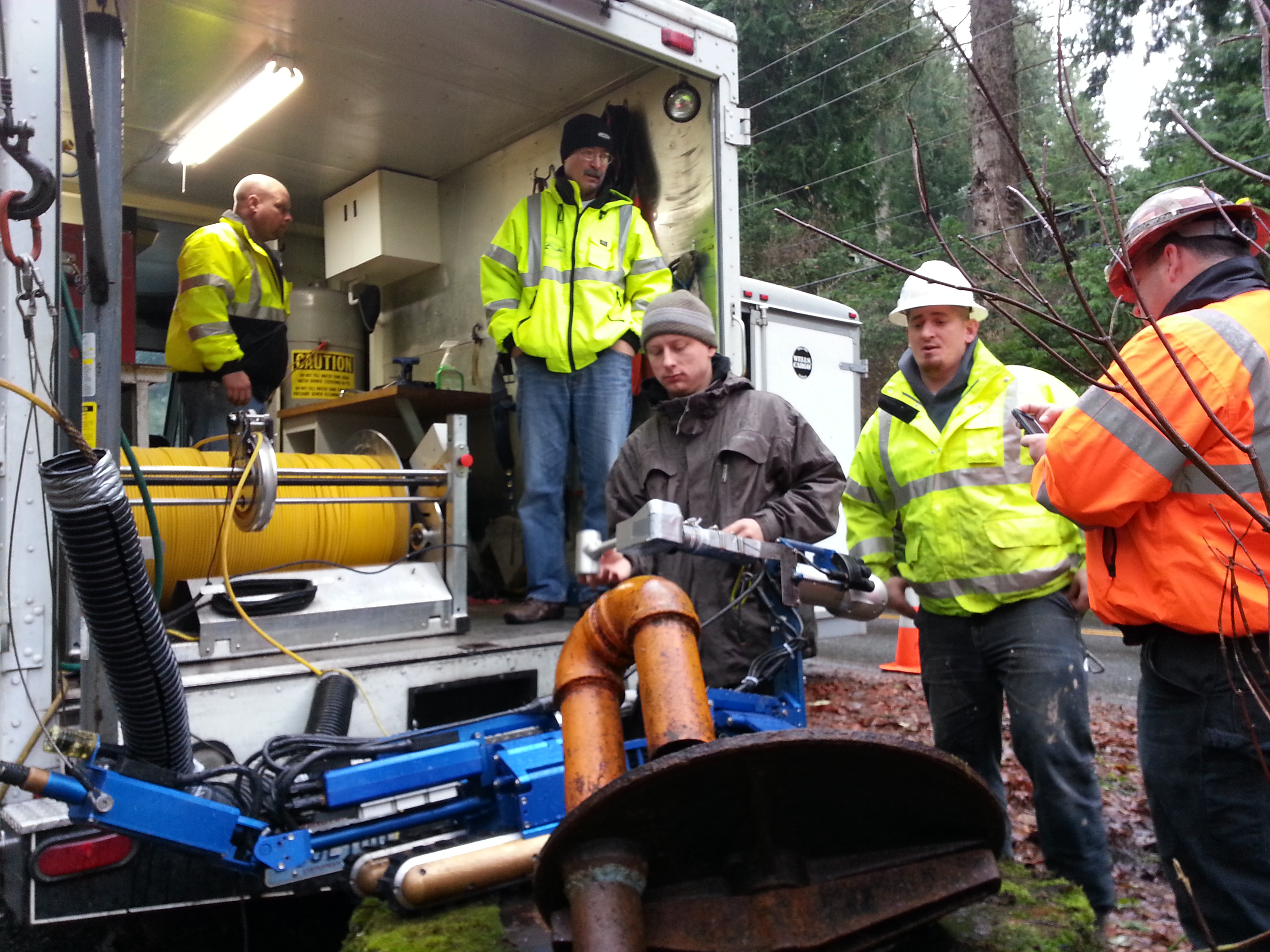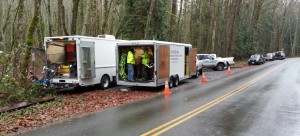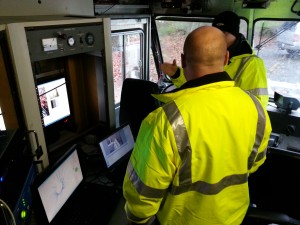December 2013, Vol. 68 No. 12
Features
Inspection Of Fully-Submerged Water Intake Tunnel

Interactive Pipe Inspection (IPI) is building an impressive record of complex inspections of pipe submerged under water. Last year, Underground Construction magazine reported on projects for King County, WA, in which IPI inspected more than 50,000 feet of sanitary sewer lines beneath two lakes.
Following that project, IPI inspected 8,700 linear feet of the fully submerged, active, Lake Whatcom raw water intake tunnel of 78-inch diameter concrete and wood stave pipe in service since the 1940s. The tunnel carries raw water from Lake Whatcom to a screen and treatment facility operated by the city of Bellingham, WA.
The inspection was made to identify needed repairs and determine whether the useful life of the tunnel segments could be extended beyond original manufacturing specifications. IPI made the inspection without dewatering the tunnel.
Although earlier inspections had been performed by man entry with the tunnel dewatered, the city did not want to dewater for this inspection due to the tunnel’s age and other factors, said Randy Wilkinson, IPI laser manager and project coordinator.
“With limited access to the mile-and-a-half-long tunnel, active water flow, 100 percent volume and water extending seven-feet upwards from the top of the tunnel and into the small access points at the intermediate access shaft and the gate house at the lake, we were presented with logistical underwater challenges,” Wilkinson said.
Cutting edge tech
Live pipe inspection was accomplished using the latest unmanned inspection technology.
“This inspection could not have been accomplished using a conventional CCTV system,” Wilkinson emphasized. “IPI contracted with Leviathan Underwater Construction International to place robotic crawler and high-definition CCTV units fitted with underwater laser equipment at the bottom of the submersed tunnel. Without damaging components, the equipment was placed in the correct position, elevation of the sensors set, all connections were checked and the tether line protection device affixed at the top edge of the tunnel. The diver’s line also assisted with additional audio, video feed and recording.”
Equipment used was an Inuktun Versatrax 300 Crawler, Inuktun Pan and Tilt Spectrum 120 camera and 2G Robotics ULS-200 underwater Laser scanner. The Inuktun Versatrax 300 is designed to complete long-range pipe inspection.
“With this system,” said Wilkinson, “IPI is able to inspect more than 6,000 feet of pipe in a single run, the first time this has been done in a municipal water system anywhere in the world using a high-resolution, 525-line CCTV Camera fitted with the an underwater laser. The Inuktun crawler and camera set up includes three onboard video cameras, multiple sensor options, and is operable in pipe with internal diameters as small as 12 inches.”

2G Robotics describes its line of underwater laser scanners and image enhancement software as exceeding the capabilities of traditional sonar and video inspection to provide detailed examination of even the slightest variances in underwater environments. 2G Robotics ULS-200 underwater laser scanners capture detailed point cloud models of underwater assets. These point clouds are digital 3D models that can be viewed and investigated digitally. Using these digital 3D models, engineers are able to obtain precise measurements.
Because of configuration of the tunnel, it was impossible to use the full 6,000-foot capability of the Inuktun system. Inspections were made in three segments of 1,076-, 3,201- and 4,423 feet.
Wilkinson said the first run was a deployment into the intermediate access in the middle of the tunnel run in the concrete lined horseshoe shaped section of the tunnel which allowed Inspection in both the upstream and downstream directions from one set-up point. The last run was the wood stave circular tunnel section where the water is collected from the lake and runs to the gate house. The approximate diameter for both the horseshoe and the circular tunnel profiles is 6½ feet.
Divers
Divers from Leviathan Underwater Services were used in all deployment and retrieval functions.
“The divers were very professional in carrying out needed underwater support of equipment placement and extra video and communication feeds while evaluating the access shafts and underwater setup functions from topside,” Wilkinson said.
IPI employed two shifts which allowed inspections to continue 24 hours per day. Project Manager Bryce James, who has NASSCO’s PACP certification, led one shift and IPI General Manager Pat Shepp supervised the other.
For overall operations, IPI crews consisted of one operator and one technician. An applications engineer from 2G Robotics also was on site. Leviathan’s crew consisted of three certified commercial divers. All were used during deployment and retrieval and the IPI crew of two for the duration of inspection.
Start-to-finish, the inspection of the 8,700 feet of tunnel was completed in five days.

“Despite project challenges,” concluded Wilkinson, “using the Inuktun Versatrax 300 system with the 2G Robotics ULS-200 Underwater Laser scanner, IPI was able to get concise measurable data. The larger and smaller system made by the same company frequently is used in open water environments, but IPI made history as the only company in the world to deploy and successfully operate this new, innovative equipment in a confined, fully submerged pipe (tunnel) in a municipal water system. The city of Bellingham made history as the first municipality to use this precise underwater technology.
“We believe this system and software are the future of pipe inspection and of our company.”
Based in Turnwater, WA, Interactive Pipe Inspection was established in 2009 as a corporation specializing in advanced technology applications for the inspection of underground pipe systems to multi-national markets. The company also has introduced a method of panoramic inspection of manholes. IPI is a division of Pipe Experts LLC, a provider of trenchless technology services for more than 30 years.
Located between the ocean and mountains with Mount Baker as a backdrop, Bellingham is approximately 90 miles north of Seattle and the last major city in the state before the Washington coastline reaches the Canadian border. The city’s 2010 census recorded a population of 80,885. Approximately half of Whatcom County residents use the Lake Whatcom Reservoir for drinking water. The Whatcom Falls treatment plant is capable of producing 24 million gallons of drinking water per day.
FOR MORE INFO:
Interactive Pipe Inspection, (800) 850-3043, http://ipi-pipe.com
Inuktun, (505) 994-0702, http://inuktun.com/industry-types/pipe-inspection.html




Comments